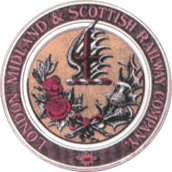LMS JOURNAL
Issues
LMSJ Issue 5
ISBN 1 874103 85 2
Contents
|

|
EDITORIAL
Some readers may know that after I left railway service in 1955, I embarked upon a career in sales and finally retired from sales management a few years ago. I mention this simply to ppint out that the experience I gained probably means that I am more commercially-minded than most railway authors or editors, which will explain much of what I am going to say.
The market for railway literature is wide and can be divided both horizontally and vertically. By this I mean that some readers are only interested in selected geographical areas and time periods, usually to the exclusion of everything else. Looking back, I can recall the time when to me pre-1923 was the dark ages of railway history and before 1900 was prehistoric; my sole interest was the era I recalled as a trainspotter and later when I worked on the railway. Fortunately, this attitude did not last and I will be eternally grateful to those who taught me the importance of fully appreciating railway history. Or, to put it another way, it's helpful and interesting to know how the British railway system developed; the hobby will sustain you for a lifetime.
The reason for raising this issue is simply to bring to readers' attention that whilst the Great Western Railway and British Railways Western Region probably have more followers for the pre-1968 era than any other company, the signs are that the LMS and those interested in the constituents of that company will exceed the GWR total. A few days before writing this editorial, I received a letter from a reader whose railway influence came from the 1950s and in particular from the Midlands. He had not read Midland Record but he enthused about LMS Journal; his was one of those ego-boosting letters. His letter was a series of questions about where he could find out about this and that. My reply kept saying that the subject had been covered in Midland Record number X, Y or Z and that whilst this was either Midland Railway or LMS Midland Division practice, the subject would not be repeated in LMS Journal, at least not as long as I remain editor! Furthermore, I stressed that the practice followed by the various British companies differed only in detail, therefore a description of what one company did probably meant that the others worked in a similar manner.
One reader said "You tell us how the railway was operated, which we like", so may I suggest that those readers who are interested in traffic matters look at past issues of Midland Record. You may find that we have already dealt with subjects that will be of interest to you.
Bob Essery
Site contents Copyright © Cygnet Magazines Limited, 2014-2025.




